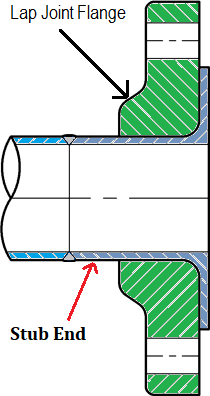

In industrial piping systems, selecting the correct flange connection is crucial for ensuring cost efficiency, ease of maintenance, and long service life. One of the most versatile and cost-saving flange assemblies is the stub end and lap joint flange combination. This pairing offers unique advantages in certain applications, especially when frequent disassembly or alignment adjustments are needed.
What Are Stub Ends and Lap Joint Flanges?
Stub End
A stub end is a short piece of pipe with one end butt-welded to the adjoining pipe and the other end formed into a flared (lap) face. The stub end serves as the sealing surface for the flange connection.
Lap Joint Flange
A lap joint flange is a loose, ring-shaped flange that slides over the stub end. Because it is not welded or fixed to the pipe, it can rotate around the stub end to align with bolt holes in mating flanges.
How They Work Together
-
The stub end is welded to the pipe.
-
The lap joint flange is slipped over the pipe and rests behind the flared face of the stub end.
-
A gasket is placed between the stub end’s face and the mating flange.
-
Bolts are tightened to secure the assembly.
Key Benefits of Using Stub Ends and Lap Joint Flanges
1. Reduced Material Costs
Lap joint flanges do not contact the process fluid—they simply press against the back of the stub end. This means the flange can be made from less expensive materials (such as carbon steel or ductile iron) while the stub end can be made from a more corrosion-resistant alloy.
Example: Stainless steel stub end + carbon steel lap joint flange = lower cost compared to a full stainless steel flange.
2. Easier Flange Alignment
Because lap joint flanges rotate freely around the pipe, they make bolt hole alignment simple, even in tight spaces or when working with large-diameter flanges.
3. Ideal for High-Maintenance Systems
In systems where pipes and flanges are frequently dismantled for cleaning, inspection, or replacement, stub ends and lap joint flanges allow for:
-
Quick disassembly
-
Less wear on gasket surfaces
-
Lower long-term replacement costs
4. Lower Replacement Costs
If the sealing surface becomes damaged, only the stub end needs to be replaced, not the entire flange.
5. Suitable for Large-Diameter, Low-Pressure Applications
Lap joint flange assemblies are especially popular in large-diameter piping where the cost savings from using carbon steel flanges instead of full-alloy flanges is significant. They are commonly used in low- to medium-pressure systems.
Common Specifications for Stub Ends and Lap Joint Flanges
Standards
-
ASME B16.9 – Factory-made wrought butt-weld fittings (stub ends)
-
ASME B16.5 – Pipe flanges and flanged fittings
-
MSS SP-43 – Stub ends for Schedule 5S and 10S piping (lightweight)
-
ASME B31.3 – Process piping code compliance
Stub End Types
-
Type A – For lap joint flanges, with a radius to match the flange’s lap joint fillet.
-
Type B – For slip-on flanges, with a square-cut end.
-
Type C – Can be used with lap joint or slip-on flanges, often fabricated from pipe.
Sizes
-
Nominal Pipe Sizes: ½” through 24” (standard range)
-
Pressure Classes: 150#, 300#, 600#, 900#, and higher (per ASME B16.5)
-
Wall Thicknesses: Matches pipe schedules (STD, XS, XXS, and Schedule 5 through 160)
Materials
Because the stub end is in contact with the process fluid, it is typically made from:
-
Stainless Steel: 304/L, 316/L, 317/L, 321, 347
-
Nickel Alloys: Alloy 200/201, 400, 600, 625, C-276
-
Duplex Stainless Steel: 2205, 2507
-
Alloy Steel: A234 WPB, WP11, WP22 (for high temperature)
-
Titanium: Grades 2 and 7 for extreme corrosion resistance
Lap joint flanges are usually made from:
-
Carbon Steel: ASTM A105, A350 LF2
-
Stainless Steel: When required for external corrosion resistance
-
Other Alloys: For special environments
Common Applications
-
Food & Beverage Processing
-
Pharmaceutical Systems
-
Chemical Processing Plants
-
Marine & Offshore
-
Water Treatment Facilities
-
Pulp & Paper Industry
Conclusion
The stub end and lap joint flange combination is a proven, cost-effective, and flexible connection method for many industrial piping systems. By separating the corrosion-resistant sealing surface from the load-bearing flange, this design reduces costs, improves alignment, and simplifies maintenance, especially in large-diameter or frequently dismantled systems.
Hayward Pipe & Supply offers a full range of stub ends and lap joint flanges in carbon steel, stainless steel, and high-performance alloys—meeting ASME, MSS, and industry-specific standards.

